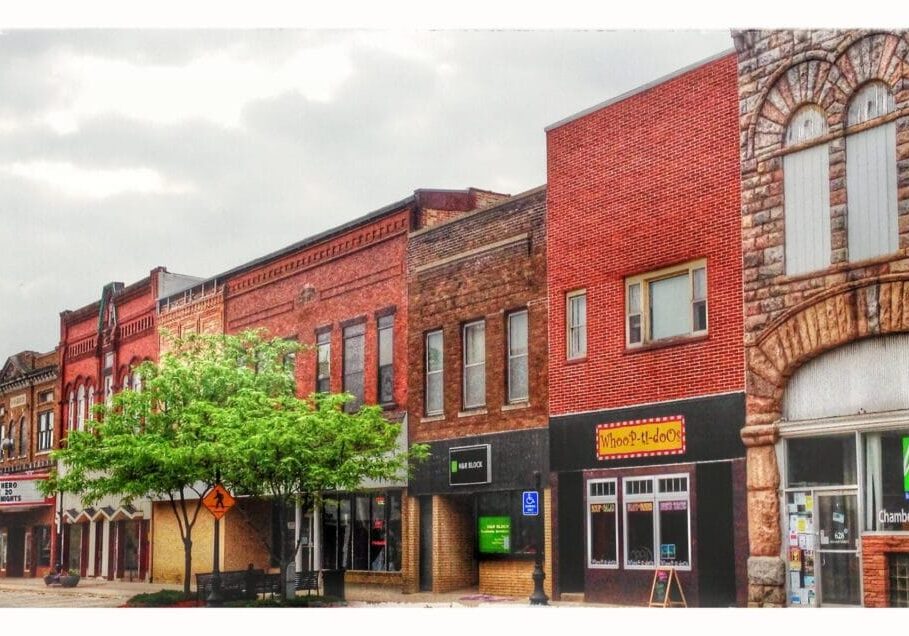
Not every second story housing project is possible by a bank loaning someone the money to build or rehab.
Webster City, Iowa has several buildings downtown with second story spaces. Three of those second stories are now housing. It wasn’t a developer that came in and bought the buildings and fixed them up. That’s a traditional way of rehabbing second stories. Right now those developers are busy with micropolitans. They can work on many buildings at a time, which is more cost efficient for them. This is a story of 3 buildings that got purchased and rehabbed without a traditional developer in a nanopolitan.
Self Funding
Jake purchased two buildings and completely gutted them. He is an electrician and owns his own business. It was a slow time during that economic downturn during the early teens and he wanted to keep his crew employed. They made it into three storefronts on the bottom, built out specifically for the new tenants who were going to rent.
The second story are 1 and 2 bedroom loft style apartments. Top of the line – cherry cabinets, skylights, hardwood floors, you get the idea. I believe there are 10 apartments. The rent is not too high. Jake wanted to keep them full with good renters, and they are. The apartments are hardly empty for more than 5 minutes – the current renters have always lined up the next set of renters. Jake got no funding, he self funded. He wanted to help build his community and knew that he could lead by example. Jake isn’t rich, he’s smart with his money.
Loan and GAP Funding
Jimmy owned an antique business in a nearby town and wanted to expand to Webster City. His wife wanted to retire from her nursing job and loves working with antiques. He bought the building next to Jakes. Jimmy and his friend cleaned out the retail space on the bottom, reinforced the floors and began moving some of his product into this location. He told his wife once he rehabbed the upstairs, she could quit her job and come work at the store.
The upstairs had been a squatters paradise and was a mess. Jimmy fixed up the front apartment and rented it out. He would continue the rehab that way – fix and rent. There are four decent apartments, simple enough and have a great view. His rents are lower than Jakes. Now Jimmy’s wife is working downstairs! Jimmy did take out a small bank loan and an USDA revolving loan fund for GAP financing. He paid the loans off in one year.
Creative Financing
Donovan has always wanted his own gym. He’s a mechanic for RV’s. When a piece of property became available downtown he wanted to buy it. It had 2 big storefronts and 10 apartments upstairs. The owner was older and having trouble keeping the property in the shape it needed to be in. Donovan wasn’t able to get the money he needed for this large purchase. Not that he had bad credit, it was a large purchase the bank didn’t think he could cover.
The couple that owned the building really wanted Donovan to have it, so they worked with him and helped him with financing. This is a benefit to living in a small town, people know each other. It’s easier to help someone you know. He’s slowly working on rehabbing each apartment. They do have people living in them, but they are more transient types of workers. There is much to do and he’s doing the work as he can, while still holding down a full time job.
Why these stories matter
There’s variety in funding in these three stories. Self funding, loan funding and creative financing. All three worked with what they had, and created 14 new apartments and are fixing several more.
Some of the decisions they made were smart.
- Jake found renters for his storefronts before the work was done.
- Jimmy finished upstairs before his wife quit her job (and holding insurance) and paid off his loans quickly.
- Donovan had a great plan, and worked with the owners for creative financing. He’s still working his day job while updating the apartments.
You don’t need developers for every housing situation. You will need permits, advice from experts and other things depending on your code. What could be possible in your town?
You can learn more about using the Idea Friendly method to create housing projects with our video: Improving Rural Housing: an Idea Friendly Approach.
Other article you may like:
https://buildingpossibility.com/city-codes-can-be-changed/
